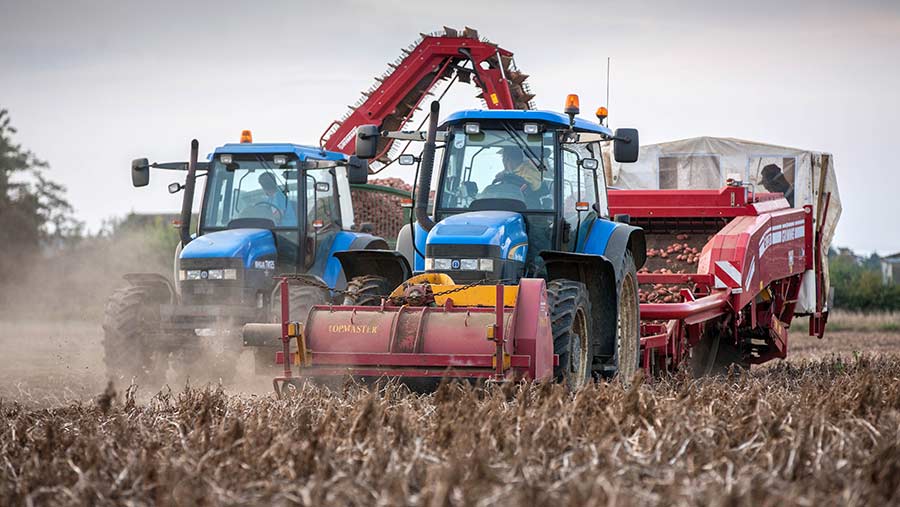Outlook 2019: Challenges remain for potatoes and beet
 © Tim Scrivener
© Tim Scrivener The weather conspired in 2019 to give potato and sugar beet growers disappointing yields. The wet late spring and and summer drought led to late planting and drilling and this was then followed by summer drought.
Anderson’s looks in detail at the markets for the year ahead for potato and sugar beet growers and gives key pointers in how to meet some of the challenges.
Potatoes
Key advice
- Review land selection to ensure viable yield and quality prospects
- Consider opportunities to improve irrigation infrastructure, including winter storage
- Review storage facilities, using advice from Sutton Bridge Crop Storage Research
- Research alternatives to diquat ahead of the forthcoming delisting.
After one of the most challenging growing seasons in recent memory, there remains uncertainty about how the smaller 2018 crop will fare through the current storage season.
The AHDB estimates last year’s planted area was the third-lowest on record, at 119,000ha. As the challenging growing season resulted in lower yields and some quality concerns, price is at the forefront for buyer and seller.
Storage quality will be a particular issue over coming months, as the rain that followed the prolonged dry summer caused agronomic issues such as bacterial soft rot and secondary growth, says Andersons’ Nick Blake.
Some varieties are likely to be more affected in store than others, and it appears processors have secured free-buy material early to reduce exposure later in the season, he says.
“Growers reacted differently to the poor growing season. There appears varying success for growers who delayed lifting to pursue yield. The gamble paid off for some, as the weather held reasonably well, but the actual yield improvement is yet to be quantified.
“Even irrigated crops suffered yield and quality issues last season. In extreme examples, it appears some crops may have been overwatered, while for others abstraction limits were imposed. The allocation of available water between crops also tested relationships between growers and land providers.”
The overall production pattern is similar across northern Europe, where approximately 70% of the crop is contracted.
Mr Blake says the widespread shortage may reduce imports into the UK. Therefore, unlike in previous seasons, price rises here should be less constrained by imports being drawn in from northern Europe.
“High prices tend to invite fresh interest in costing models to arrive at a price formula. However, these are not straightforward and tend to not to take account of risk.
“The required return will vary significantly between businesses and a general approach is to focus on cost of production rather than margin, to leave the price to be determined.”
While growers will hope 2018 was an extreme year, the water shortages many experienced reinforce the benefit of winter water storage, he adds.
Sugar beet
Key advice
- Consider potential savings from British Sugar Haulage Scheme
- Review options to reduce cost of production such as field edge loading where feasible
- Select land carefully to avoid compromising output.
The 2018/19 sugar price announcement came around eight weeks later than last year and failed to deliver on hopes for an increase.
Wheat price and exchange rate have influenced the beet price in previous contract price mechanisms, but this is no longer the case, says Mr Blake.
Despite British Sugar citing the end of the EU sugar regime as an opportunity to increase sugar production, Brexit-related trade uncertainties and the low EU sugar price following abolition of quotas mean lower sugar production may be a (temporary) change in strategy.
“The price announcement appears to be designed for a reduction in volume for the 2019/20 campaign,” says Mr Blake.
Indeed, earlier in the year the record low EU sugar price prompted the International Confederation of European Beet Growers to call for, among other things, a level playing field and pressure on countries dumping subsidised sugar on to world markets.
“Unsurprisingly, there is unlikely to be any market-related bonus for the 2017/18 crop.”
For 2019 one-year contracts the revenue share threshold has been reduced from €475/t to €375/t, with an increase in the share of the uplift to the grower, although Mr Blake says it remains to be seen whether, given current market prices, this is likely to generate additional income to growers.
For one-year contract growers the 2018/19 price will remain at just over £20/t.
Once multi-year contracts have run their course, the price falls to £19.07/t in two years’ time, subject to subsequent price changes, but the adjusted tonnage sold will increase to account for the crown tare previously deducted.
“British Sugar is working to take cost out of the supply chain with haulage and grower groups, while at the same time negotiating the price for a product where for many growers the few alternative break crops are loss-making at net margin level.”
FW arable editor says

Richard Allison, arable editor
On the back of a challenging season for sugar beet, there will be no let up next season and the crop is starting to look less attractive. A 2019 beet price of less than £20/t angered many growers, squeezing margins.
However, a growing problem is the loss of key agrochemicals in 2019, including thiram and neonicotinoid seed treatments.
Losing neonicotinoid seeds treatments leaves beet crops vulnerable to aphids carrying beet yellows virus. French experience in recent untreated trials saw yield losses of up to 30%.
Potato growers are also grappling with the loss of agrochemicals – losing diquat will make desiccation much more challenging in 2019 and blight is gaining resistance to fungicides, with a second mode of action being affected.
Farmers will need to tweak their fungicide strategies for the season ahead, if they are to keep on top of the crop’s number one disease.
